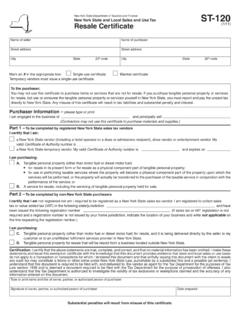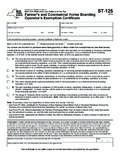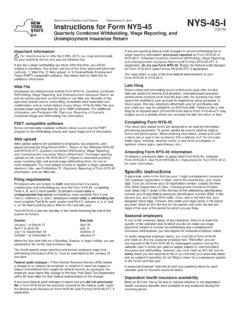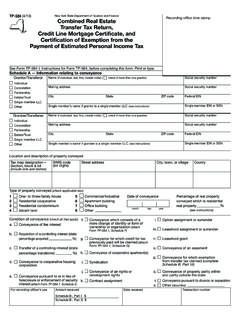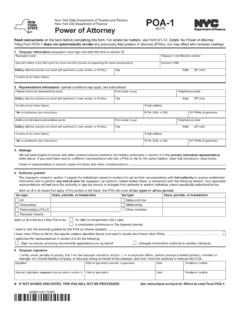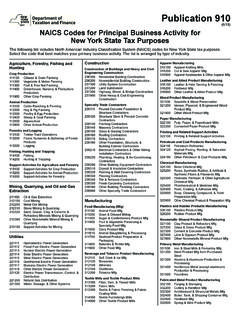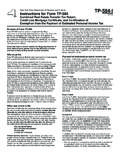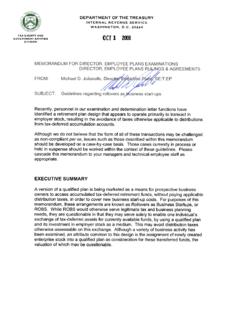Transcription of Department of Taxation and Finance Instructions for Form ...
1 All citations are to New York State Tax Law sections unless specifically noted of Taxation and FinanceInstructions for Form and Other Exempt Income andInvestment CapitalGeneral informationInvestment income and other exempt income are subtracted from entire net income (ENI) in the computation of business income. Investment capital is subtracted from total net assets in the computation of the capital base. Neither gross investment income nor gross other exempt income is included on Form CT-3 or CT-3-A, Part (including combined groups) must subtract from gross investment income any interest deductions directly or indirectly attributable to investment capital or gross investment income. Taxpayers (including combined groups) must subtract from gross other exempt income any interest deductions directly or indirectly attributable to gross other exempt income. Interest deductions must be attributed regardless of whether or not income is actually earned in a particular tax year.
2 In lieu of actual attribution, a 40% safe harbor election may be made by completing Schedule A. For specific rules regarding the computation of interest deductions attributable, see TSB-M-15(8)C, Direct and Indirect Attribution of Interest Deductions for Article 9-A Taxpayers and TSB-M-19(2)C, Attribution of Interest Deductions for Article 9-A Taxpayers with Repatriated Income or IRC 163(j) purposes of calculating investment income, other exempt income, the attribution of interest deductions, and the safe harbor election, the combined group is treated as a single corporation and computes these amounts on a combined basis. All intercompany transactions and activity must be purposes of these Instructions , gross other exempt income, gross investment income, gross exempt cross-article dividends, gross exempt controlled foreign corporation (CFC) income, and gross exempt unitary corporation dividends is the amount of each of these types of income as defined in and , but before the 40% safe harbor reduction or any subtraction for the attribution of interest of formForm provides detail for the amounts reported on certain lines of Form CT-3 or CT-3-A, Parts 3, 4, 5, and A is used to make the 40% safe harbor election.
3 Schedules B and C compute other exempt income and investment income, D computes the total amounts that are reported on Form CT-3 or CT-3-A, Part 3, lines 8 and E computes investment capital, and Schedule F computes the addback of prior year presumed investment capital and income. Total amounts are reported on Form CT-3 or CT-3-A, Part 3, line 12, and Part 5, lines 16, 17, 18, and exempt income, investment income, and gross investment income are subject to certain limitations outlined in Table A: Summary of applicable A: Summary of applicable limitationsItemDescription of limitationNew York State Tax Law Gross investment incomeLimited to the greater of 8% of ENI or the amount of gross income (including gains in excess of losses) that taxpayer claims New York cannot constitutionally (a)(iii) (e)Other exempt income*Limited to (d)Investment income*Limited to ENI minus other exempt (a)(i) of investment income* and other exempt income*Limited to capital**Not impacted by any of the limitations on investment income.
4 The net average FMV of any particular item of investment capital cannot be less than (b) * after the 40% safe harbor reduction or any subtraction for the attribution of interest deductions ** net of liabilities attributable(continued)Page 2 of 6 (2021)Specific instructionsWhen filing a combined return, enter the legal name and employer identification number of the group s designated A 40% safe harbor election In lieu of subtracting from gross investment income and gross other exempt income the actual amount of interest deductions directly and indirectly attributable to such income and to investment capital, taxpayers may make a revocable election to reduce such income by 40%; provided, however, that the safe harbor election does not apply to gross exempt cross-article dividends. Interest deductions must always be attributed to gross exempt cross-article dividends, regardless of whether or not the safe harbor election is made.
5 Any such election applies to all members of the group. If you subsequently revoke this election, it is revoked for all such income. To revoke this election, file an amended return using actual attribution. ( (b) and (b))Certain rules apply; see TSB-M-15(8)C, TSB-M-19(2)C, and the Instructions for Schedules B and 1 To make this revocable election, mark an X in the B Other exempt income ( )Schedule B computes other exempt income. You must complete this schedule when you own any assets that could generate other exempt income, regardless of whether or not such other exempt income is actually earned in a particular exempt income means the sum of exempt CFC income and exempt unitary corporation dividends. It does not include any amount treated as dividends pursuant to Internal Revenue Code (IRC) section 78. However, if a stock that generates other exempt income is itself marked to market, and the 8% fixed percentage method election for apportionment is made, no income from such stock is includible in other exempt income for that tax year.
6 For more information concerning marking to market, and the 8% fixed percentage method election for apportionment, see Form CT-3-I or Form CT-3-A-I, Part 6, line 8 CFC income means the sum of: a) Subpart F (of the IRC) income (other than that described in (b) below) and investment of earnings in property required to be included in the taxpayer s federal gross income per IRC section 951(a), received from a corporation that is conducting a unitary business with the taxpayer but is not included in a combined return with the taxpayer ; plus b) mandatory deemed repatriation inclusion amount required to be included in the taxpayer s federal gross income per IRC section 965(a), as adjusted by IRC section 965(b) and without regard to IRC section 965(c) received from a corporation that is not included in a combined return with the taxpayer ; plusc) 95% of the global intangible low-taxed income (GILTI) required to be included in the taxpayer s federal gross income per IRC section 951(A)(a) without regard to the deduction under IRC section 250, that is received from a corporation that is not included in a combined return with the taxpayer ; less d) any interest deductions directly or indirectly attributable to the income.
7 In lieu of attribution, you may make a revocable election (by completing Schedule A) to reduce gross exempt CFC income by 40%. If you make this election, it also applies to gross investment income and gross exempt unitary corporation dividends. If you do not make this election because you do not have gross exempt CFC income, you will not be precluded from making those other amounts do not constitute exempt unitary dividends or investment income. Exempt unitary corporation dividends means those dividends from a corporation that is conducting a unitary business with the taxpayer but is not included in a combined return with the taxpayer , less any interest deductions directly or indirectly attributable to such income. In lieu of attribution, you may make a revocable election (by completing Schedule A) to reduce gross exempt unitary corporation dividends (except for gross exempt cross-article dividends) by 40%. If you make this election, it also applies to gross investment income and gross exempt CFC income.
8 If you do not make this election because you do not have gross exempt unitary corporation dividends, you will not be precluded from making those other elections. The safe harbor election does not apply to gross exempt cross-article dividends; interest deductions must be directly or indirectly attributed to gross exempt cross-article purposes of these Instructions , the term exempt cross-article dividends means dividend income received from unitary corporations that are taxable under a franchise tax imposed by Article 9 or Article 33, or that would be taxable under those articles if subject to tax, but are not included in a combined return with the taxpayer , less any interest deductions directly or indirectly attributable to such income (the 40% safe harbor does not apply). Exempt cross-article dividends are one type of exempt unitary corporation exempt income cannot exceed ENI. If you attribute interest deductions to gross other exempt income and the amount attributed exceeds gross other exempt income, the excess must be added back to : If you made the safe harbor election, complete Parts 1, 2, 6, and 7.
9 If you did not make the safe harbor election, complete Parts 1 through 5 and Part 1 Line 1a Enter 95% of the GILTI income received from a corporation that is not included in a combined return with the 1b Enter the result of adding: the mandatory deemed repatriation inclusion amount that is received from a corporation that is not included in a combined return with the taxpayer , plus any other Subpart F (of the IRC) income and investment of earnings in property received from a corporation that is conducting a unitary business with the taxpayer but is not included in a combined return with the 2 Enter your total amount of gross exempt unitary corporation dividends other than gross exempt cross-article dividends, which are reported separately on Part 2, line 4 If you made the safe harbor election by marking an X on Schedule A, line 1, multiply line 3 by 40% (.40) and enter the result. See the Instructions for Schedule 2, 3, and 4 Lines 7, 8, 12, 13, 15 and 16 For specific rules regarding the attribution of interest deductions, see TSB-M-15(8)C and TSB-M-19(2) 10 and 11 Complete these lines only if the safe harbor election is made; otherwise, continue with Part 12 and 13 Complete these lines if not making the safe harbor election; report interest deductions directly and indirectly attributable to the gross exempt CFC income reported in Schedule B, lines 1a and (2021) Page 3 of 6 Lines 15 through 17 Do not include any interest deductions attributable to exempt cross-article dividends.
10 Schedule C Investment income ( and )Schedule C computes investment income. You must complete this schedule if you own any assets that could generate investment income, regardless of whether or not such income is actually earned in a particular tax income means income, including capital gains in excess of capital losses, from investment capital, to the extent included in computing ENI, less any interest deductions allowable in computing ENI which are directly or indirectly attributable to investment capital or gross investment income. See Schedule E Instructions for definition of investment income or gain from a debt obligation or other security cannot be taxed by New York as a result of constitutional principles found in decisions of the Supreme Court, the debt obligation or other security will be included in investment capital; any such income or gain, less interest deductions directly or indirectly attributable to such income or capital, is included in investment income.
